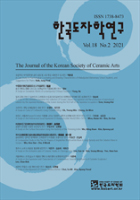
대한제국기 이화문백자(李花文白磁)의 용도와 성격
Use and Characteristics of Ihwamun White Porcelain during the Korean Empire: Focusing on the Collections of the National Palace Museum of Korea and the Seoul Museum of History
- 한국도자학회
- 한국도자학연구
- Vol.20 No.2
- 2023.08
- 61 - 80 (20 pages)
본 논문은 대한제국기의 표상인 이화문을 장식한 백자들이 근대국가로서의 면모를 갖추어 가는 과정에서 전개되는 특징적 양상을 분석하고 이들이 지닌 상징성과 영향력을 고찰하는데 목적을 두었다. 이 시기는 서구열강들과의 수교조약 체결 이후 이화문백자의 제작을 범국가적인 차원에서 전개시켰고, 각계각층의 외교사절들과 황실 구성원들의 연회, 사교 모임 등을 위해 다양하게 쓰였다. 그러나 이화문백자는 조선 말기 분원의 민영 이후 쇠락한 요업실태를 극복하지 못해 수입에 의존했다. 비록 이화문백자는 수입 의존이 불가피했지만 서양식 연회에 활용될 경우 황실을 상징하는 것은 물론 서구열강과의 외교정책과 교류에 손색이 없는 구성을 갖추었고, 서양 식문화의 격식 역시 거의 완벽에 가깝도록 준비하였다. 따라서 이화문백자는 국내 제작의 한계를 경험했지만 근대화된 황실문화와 서양자기제도술(製陶術)을 인식하는 계기가 되었다. 특히 이 백자들은 서양문물의 수용을 단편적으로 이해할 수있으면서 국내 요업과의 인과성 및 황실 내부의 인식 변화과정을 분석할 수 있는 대표적인 사례로 볼수 있다는 점에서 주목된다.
The purpose of this thesis is to analyze the characteristic aspects of the white porcelains that decorate Ihwamun, the symbol of the Korean Empire, in the process of becoming a modern nation, and to consider their symbolism and influence. During this period, after the signing of the Treaty of Demand with Western powers, the production of Ihwamun white porcelain was developed on a national level, and it was used in various ways for diplomatic envoys from all walks of life and members of the imperial family for banquets and social gatherings. However, Ihwamun depended on imports because it could not overcome the decline of the ceramic industry after the private management of Bunwon(分院) in the late Joseon Dynasty. Although import dependence was unavoidable, when used for Western-style banquets, it not only symbolized the imperial family, but also had a composition suitable for foreign policy and exchange with Western powers, and the formality of Western food culture was also prepared to be almost perfect. Therefore, IhwaMun porcelain experienced the limitations of domestic production, but it served as an opportunity to recognize the modernized imperial culture and Western porcelain drafting techniques. In particular, these white porcelains are noteworthy in that they can be seen as a representative case for analyzing the causality of domestic ceramics and the process of changing perceptions within the imperial family while being able to understand the acceptance of Western culture in a fragmentary manner.
Ⅰ. 머리말
Ⅱ. 대한제국 문장(紋章) 이화문의 도입과 다각적 활용
Ⅲ. 이화문백자를 통해 본 황실 도자문화의 특징적 양상
Ⅳ. 이화문백자의 상징성과 근대 자주국가로서의 영향력
V. 맺음말
참고문헌